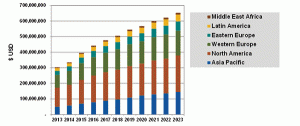Sam Jaffe, Senior Research Analyst – Energy
Navigant Research
It’s hard to forget the scene from the 1987 movie Wall Street when Michael Douglas is walking down the beach in front of his Hampton’s beach house holding a two-liter bottle-sized cell phone to his head. It was the first time most of the movie’s viewers had ever seen such a thing and it made a lasting impression. Soon, these enormous devices would become the status symbol of the ages. Owning a cell phone wasn’t just about making calls. It was about being seen making calls.
That hasn’t changed two and a half decades later. But the phones themselves have changed enormously. For 20 years, they continuously shrank until, in the 2001 movie Zoolander, Ben Stiller was seen holding a thimble-sized phone. Then the phones, as they gained functionality (texting, game playing, Internet access, etc.), the phones started getting bigger again. From a technological perspective, the story of the cellphone over the last 30 years has been the story of processors, the chips that actually allow you to talk wirelessly. As the processors got smaller and faster, so did the phones. And at a certain point they became so powerful and small that the phones stopped being phones and became hand-held computers.
Today’s smartphones are no longer limited by their processors. A simple 1.6 GHz. Quad-core Exynos powers the Samsung Galaxy S4 (the hot phone of the moment) and allows it to perform multiple tasks simultaneously while continuously communicating with several networks and satellites. But today’s phones are limited by another component that, until now, had been an engineering afterthought: the battery. Phone purchasers usually rate battery life and battery longevity as two of the most important factors in which phone they choose. And while processors have been shrinking at an exponential rate, batteries have not. Most phones use a very similar chemistry to the same cells that went into phones a decade ago. That is about to change, as new battery chemistries and new power control architecture start to be experimented with. The battery is to tomorrow’s cell phone designs what the processor was to the past generations of phone designers.
And this phenomenon is not limited to cell phones. Every portable device, from cordless drills to hand-held point-of-sale units to pacemakers, is under the same end-user pressure to improve battery charge time, power capacity and longevity while not compromising on cost and safety. Portable device designers are experiencing their Copernican moment. When Nicholas Copernicus proved in the early 16th century that the Earth revolved around the Sun, and not the other way around, it caused a scientific, philosophical and theological revolution that still echoes today. In a similar fashion, device engineers are learning that the key to making a popular device is not about how fast the CPU is, but about how well the battery performs.
This transformation is happening on multiple fronts. The most important elements of it are in battery chemistry, power control design and device layout.
Basic battery chemistry is flourishing, with multiple new molecules being investigated as cathodes, anodes and electrolyte. Although most of this research is being cloaked in the robes of electric vehicle enablement, the fact is that rechargeable cells for portable devices are still the largest single battery market. Most current devices use some form of lithium-ion batteries, with consumer electronics sticking to traditional lithium cobalt oxide formulations for the cathode and power tools frequently sporting lithium iron phosphate cells. However, new systems that utilize solid electrolytes promise a significant improvement in energy density and longevity. An even more promising chemistry is lithium sulfur, which could double or even triple the energy density of most devices while maintaining their useful lifetime of 24 months. Farther out in the future, emerging research around lithium oxide batteries, which utilize the oxygen in the ambient air for the cathodic reaction, could improve energy density by as much as 10-fold.
Power control design in today’s cellphones is a relatively simple affair. Most phones utilize a single Texas Instruments power control processor (which costs less than a dollar when ordered in bulk) that regulates current based on feedback from three sensors that measure current, voltage and temperature. Newer power control designs monitor things like device harmonics and frequency that allow the control of the battery to be much more precise. Additionally, power control is being managed from the application end differently. For instance, the most notorious power glutton of a modern smartphone is the global positioning system (GPS) chip, which allows the phone to be precisely located and mapped. New GPS chip designs utilize different architectures to achieve as much as a four-fold reduction in power draw.
Device designers are also exploring new system layouts that allow thermal management to be more easily accomplished. A typical cordless drill of five years ago, for instance, held the nickel cadmium battery cells (which are much more resilient when temperatures get high) inside the drill handle. Most lithium ion drills today have a battery pack that attaches to the bottom of the handle, separating the battery cells from the drill motor, which can generate a tremendous amount of heat. Phone, tablet and laptop computer designers are also experimenting with new system layouts that ensure that heat flow from the batteries don’t interfere with the processor, and vice versa. The utilization of pouch cells in tablet computers is a good example of this, as the large surface area pouches shed heat more quickly than traditional cylindrical cells.
Another sign of the importance of power management becoming the de facto king of design specifications is the evolution of the component it dethroned: the processor. When ARM chips became the standard in cell phones and tablets, it was primarily because of their power-sipping functionality. Intel, computing’s processor heavyweight, has answered back with a series of new chips that utilize power in different ways so that the overall load that the chip draws is diminished. The new Haswell chip, which is being launched this summer, is capable of reducing power consumption by 50 percent, without impacting performance.
If computers, cordless drills and smartphones are all being asked to use less power, provide more functionality and carry more energy onboard, imagine the pressures being exerted on wearable device engineers. This new device category includes accessories with computers built in (such as Google Glass and Apple’s rumored iWatch), as well as other wearable devices that measure fitness and sleep patterns, such as Nike’s Fuel Band and FitBit. Each of these systems has a form factor that is a fraction the size of a smartphone, with an equivalent amount of computing happening inside. This category will probably have the greatest desire for new types of batteries, because the size of the systems is so small. Already, beta testers of the Google Glass prototypes have complained that the eyewear can only browse the web for four hours at a time, an accomplishment that would have been lauded as a breakthrough just a few years ago. End user demands for all devices will in the end be the biggest stimulant for innovation in battery and power management.
Device Battery Market Forecasts
Navigant Research has begun tracking the portable device battery market because this is still the world’s biggest battery market. In 2013, Navigant Research estimates that the global market for portable device advanced batteries will reach $8 billion. That market will continue to grow at a 5.3 percent pace, reaching $13.8 billion in 2023. To analyze this market, Navigant Research segments it into five primary markets: consumer electronics, power tools, downhole drilling, medical and defense. The following sections look in detail at each of these segments.
Consumer Electronics
This segment covers rechargeable batteries for every portable computing device that is used in hand-held devices for consumer or commercial purposes. That stretches from smartphones and tablets to point-of-sale devices and even cordless toothbrushes. The consumer electronics space is completely dominated by lithium cobalt oxide cells, which have a high energy density (between 120 and 160 Wh’s per kilogram) and an acceptable safety profile for small devices.

Navigant Research expects that laptop battery cells, the traditional dominant market in the consumer electronics space, will steadily decrease from 2013 onwards as laptop sales decline due to competition from tablets and even smartphones. At the same time, the emerging wearables segment will dramatically expand over the next 10 years, eventually rivaling all other devices in terms of unit shipments. However, the overall energy capacity of wearables batteries will be a fraction of other consumer electronics devices, because each device has such a small battery.
Today, most of the batteries for consumer devices are manufactured in Asia (primarily in China, but also in Japan and South Korea). Navigant Research expects that state of affairs to continue, as most electronics are manufactured in Asia and it makes sense to make the batteries there too. However, as some large scale manufacturing starts to return to North America, an emerging consumer electronics battery industry will be revivified on that continent too.
Power Tools
This market has seen a dramatic change in chemistry from the long-standing mainstays nickel cadmium and nickel metal hydride to lithium ion over the last ten years. The portable computing market has always relied on lithium ion (since the first introduction of commercial lithium ion cells in 1991). The power tool market, however, is a more recent convert, with the first lithium ion tools being introduced five years ago and now the entire market being dominated by that chemistry. Nickel cadmium is being phased out because it is less energy dense than lithium ion and because it presents a toxicity challenge when it is thrown away, since the highly dangerous cadmium can leach out of the batteries in landfills. Thus, lithium ion has become the de facto king of almost all power tools devices in only a few years time.
Power tool demands are significantly different from consumer electronics, though. Power tools require large, infrequent bursts of power over short periods, whereas most consumer electronics need a slow and steady source of energy. Thus many power tool batteries utilize the lithium iron phosphate chemistry, which has a better power profile.

The power tool industry is especially sensitive to new construction, so the regions where there is a significant amount of new construction (such as Latin America, Asia Pacific and Middle East Africa) will see the greatest growth in power tool battery growth. However, North American and Western European growth will continue at a healthy clip as well.
Medical

The implantable medical device industry is growing above 20 percent annually for the last decade and Navigant Research expects that to continue. Most such devices utilize long-lasting primary batteries, however an emerging trend in the field is to build the devices around rechargeable batteries that can be recharged inductively through the skin. Although the overall market for rechargeable medical device batteries is growing off of a miniscule base, Navigant Research is tracking the market because it holds out so much promise for future growth.
Defense
The global defense industry is an enormous consumer of batteries. However the majority of those batteries are used in vehicles or for stationary power applications, an area which Navigant Research covers but is not included in this study. The defense-related portable device battery market is an important element of the overall portable device market, as defense requirements often drive innovation and new chemistries. The modern soldier usually carries as many as 12 battery powered devices, all of which have to remain powered during the course of a multiple-day mission. Thus high-density and lightweight portable batteries are a frequent demand of soldiers in the field.
This market is relatively small in comparison to the others, however Navigant Research follows it because it is often a harbinger of change in other fields. Modern soldier systems are dominated by lithium ion chemistries and will be for some time.

Downhole Drilling Batteries
The modern drilling industry utilizes batteries in the downhole drill-string in order to power sensors, tools and communications devices that let the rig operator know what is happening at the drillbit level. The downhole conditions require batteries that can withstand extremely high temperatures (from 120°C to 225°C) and resounding vibration pressures while remaining safe and effective. Thus the dominant cell choice today are lithium thionyl chloride primary batteries. However the presence of a rechargeable battery in the drillstring would allow for significant cost savings as well as fewer field errors.
Navigant Research expects that rechargeable downhole batteries will become an increasingly important part of the industry going forward, especially in regions where new fields are being opened up with horizontal drilling systems (which require extensive use of batteries).

Overall Portable Device Battery Market
In the third quarter of 2013, Navigant Research will release its Advanced Battery Tracker, which will track battery supply and demand for all the major industry segments, including electric vehicles, stationary storage and portable devices. The portable device market is still the single largest market for batteries today, although that will change by 2015 as electric vehicles will use more batteries than any other market at that point. However, the portable device market will always drive innovation in the battery space and will remain a multi-billion dollar market for the foreseeable future.
For more information, contact Navigant Research at www.navigantresearch.com







